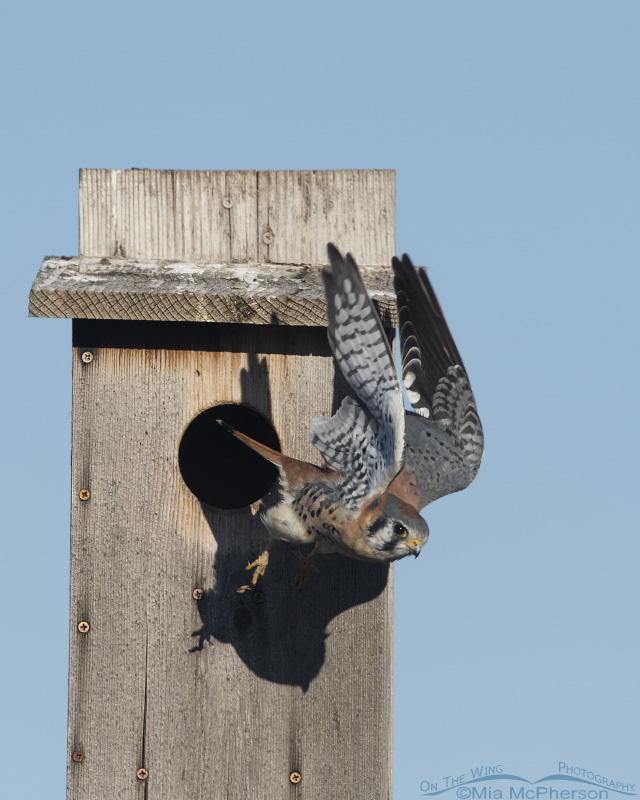 Male American Kestrel taking off from a nest box _ Nikon D810, f7.1, 1/2000, ISO 400, +0.3 EV, Nikkor 500mm VR with 1.4x TC, natural light, not baited
Male American Kestrel taking off from a nest box _ Nikon D810, f7.1, 1/2000, ISO 400, +0.3 EV, Nikkor 500mm VR with 1.4x TC, natural light, not baited
I photographed this male American Kestrel a few days ago at Farmington Bay WMA as it flew out of a nest box. It seemed strange to see the kestrel checking out the nest box at this time of the year but they do check into them to see if any nest maintenance needs to be done. Or perhaps it is because the weather has been so odd.
A little information about nest selection process for American Kestrels from allaboutbirds.org:
American Kestrels nest in cavities, although they lack the ability to excavate their own. They rely on old woodpecker holes, natural tree hollows, rock crevices, and nooks in buildings and other human-built structures. The male searches for possible nest cavities. When he’s found suitable candidates, he shows them to the female, who makes the final choice. Typically, nest sites are in trees along wood edges or in the middle of open ground. American Kestrels take readily to nest boxes.
Mia
Click here to see more of my American Kestrel photos plus facts and information about this species.


I love that they adapt to nesting boxes. And that people provide them. A lovely example of non-invasive support. Which I would like to see a LOT more of.
Beautiful photo, Mia. Such an interesting bird.
Exquisite form and shadow! He may be as confused about the weather as we are. Love how his body breaks up the straight line of the nesting box. Neil, happy to hear they are doing well in the Great Basin area. We must have hope. Thank you, Mia.
Thank you Liz, Neil and Patty.
Neil, that is the box on Goose Egg Island and it is very exposed at the top of the hill.
I also saw a Red-tailed Hawk yesterday flying with nesting material in its bill. Odd for this time of year.
Thanks for the info Mia. This winter is expected to be warmer than normal so I wouldn’t worry too much (didn’t mean to alarm anyone!). Also: resident raptors that remain on their territory year-round (such as some Red-tails in this area do) often bring nesting material back to the nest at any time of year. We see Golden Eagles do this throughout the year as well. While it is hard to say for sure, they may do this to reinforce their bond to their territory or nesting location, or show other birds in the area that they are indeed still occupying their territory.
Thanks for the information Neil! I text discussed the RTH with Jerry yesterday
Sounds like Kestrel nesting boxes put up in cold areas should have insulation…for example, double thick walls, floors and ceilings. They are such beautiful little birds, and apparently on the decline, it would be a shame to lose a single one if it could be avoided.l
Hi Patty: this is indeed something that could be done. Or placing boxes in less exposed areas that have warmer micro-climates could be another option. As I mentioned, this happened during one particularly cold 2-week period one winter, and it is likely many of these kestrels might have died anyway from the weather, but that we just happened to find them in nest boxes. It’s also likely that many other kestrels died from the cold that winter that did not roost in the boxes, but we never found them. Another thing to note is that while kestrels are on the decline in some areas (the northeast for example), they are doing quite well in other places like the Great Basin. There is much to be hopeful about!
Mia: we had kestrels roost in nest boxes during the winter while I was living in Boise. At times, when it got really cold one winter (sub-zero), this behavior actually caused several kestrels to die within the boxes as they provided little insulation (probably not as much insulation as a natural cavity might provide). Good thing our winters are getting warmer!
Wow, I didn’t know that kestrels used nest boxes. Great action photo.